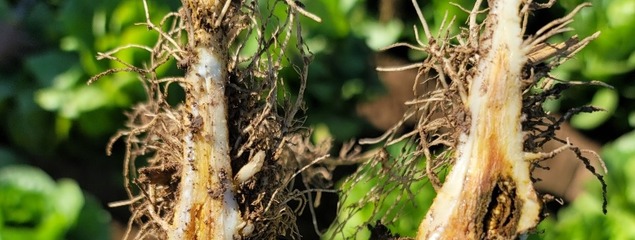
Plant Disease Management
Fusarium Wilt of Lettuce
Fusarium wilt of lettuce is a relatively new disease of lettuce, having been first described in 1967 in Japan. In Arizona, the disease was first reported in 2001 and has since spread throughout the lettuce production areas of the southwest US. The disease affects all lettuce types but is more prevalent in crisphead and leaf types. Symptoms include severe stunting of lettuce plants with diseased roots showing dark brown streaking and necrosis of the vascular tissue extending from the taproot into the stem. When the disease occurs in seedlings and young lettuce, the plants collapse and die quickly. In mature plants, disease symptoms may not be immediately evident, but will quickly become visible following warm days when the transpiration load is high. At this stage, the disease can be mistaken for lettuce drop caused by Sclerotinia sclerotiorum. However in contrast to lettuce drop, in a Fusarium-infected plant, the lettuce crown will not be completely decayed, there will be no white mycelia growth around the crown and taproot, and there will be no sclerotia visible.
Resources
- Document
- Document
- Document
- Document
- Document
- Document
- Document
- Document
- Document
- Document
- Document
- Document
- Document

